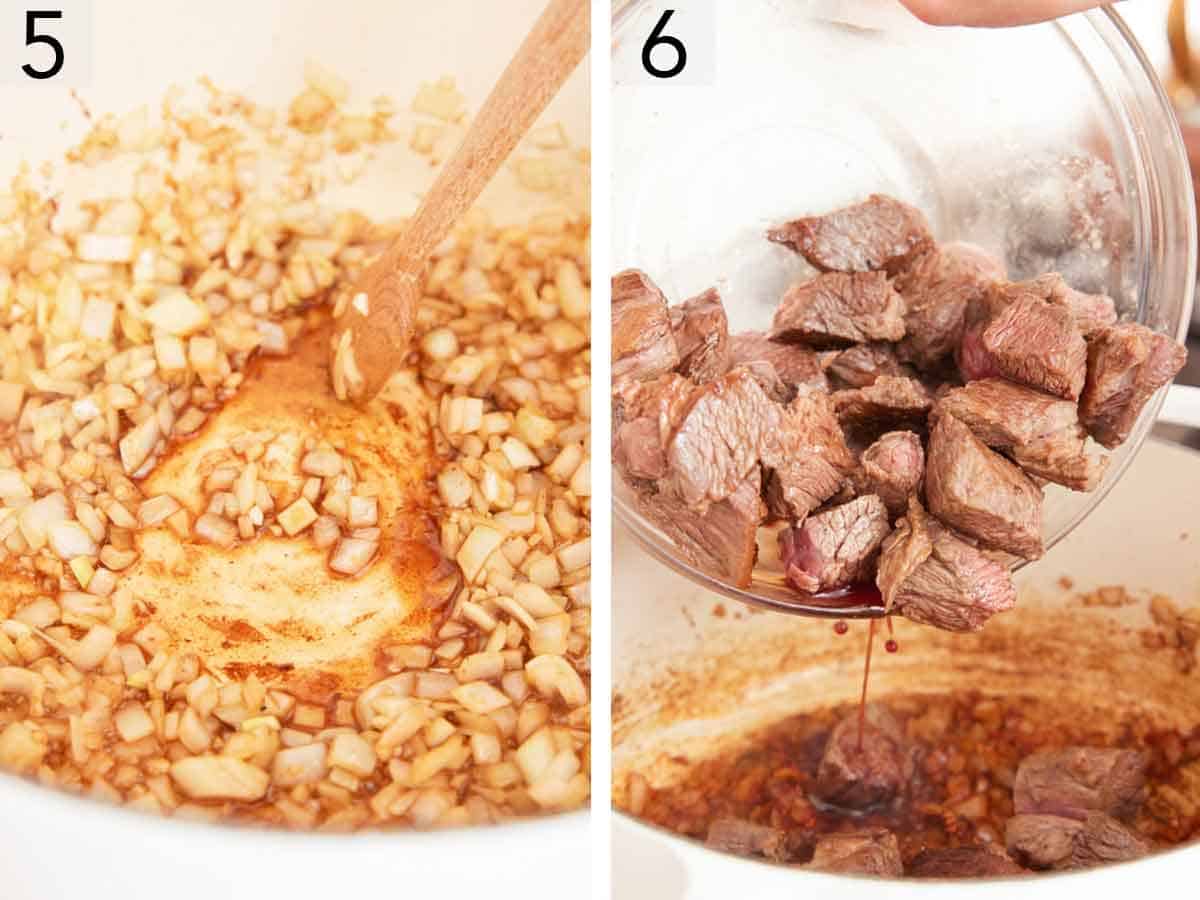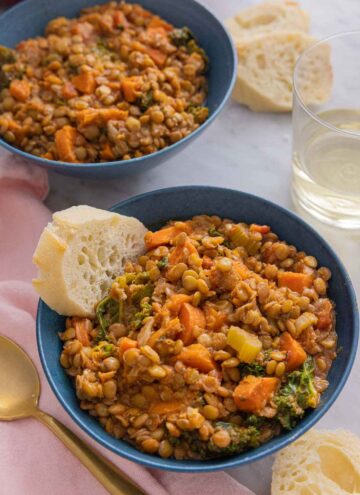Hearty Beef Stew is the ultimate one pot meal that’s simple, filling, and packed with protein and vegetables. Never short on flavor, this classic dish is made with beef broth, red wine, fresh thyme, and a bit of balsamic vinegar to create a savory and flavorful broth with a rich mouthfeel. The stew thickens as it simmers, or you can thicken the broth to your preferred consistency with an easy cornstarch slurry.
One of the secrets to making the best beef stew recipe is cubing a boneless beef chuck roast instead of buying pre-cut stew meat. The beef is browned in a cast iron pan to add color and flavor and then softens perfectly as it slowly cooks with the broth and vegetables. And this recipe only gets better with time, so it’s the ideal make-ahead meal. For more hearty soup recipes, try my potato soup, chicken stew, or tortellini soup.
What You Need to Make This Recipe

Beef – use a boneless chuck roast with good marbling for this homemade beef stew, cut into 1-inch pieces. Precut beef stew meat is often a lower-quality cut of meat that has less flavor.
Vinegar – a small amount of balsamic vinegar will balance the flavors in this recipe and will help tenderize the meat as it cooks. You can also substitute Worcestershire sauce for the vinegar.
Tomato Paste – adds concentrated tomato flavor and aids in thickening the broth without adding too much additional moisture to the dish.
Flour – all-purpose flour will thicken the broth when cooked with the browned beef. Alternatively, you can thicken the stew using a slurry of cornstarch and water.
Red Wine – a dry red wine adds rich flavor to this recipe that sets it apart. I like to use Cabernet Sauvignon, Merlot, or Pinot Noir. To make this recipe without wine, replace it with an equal amount of beef broth.
Potatoes – Yukon gold potatoes are the ideal potato for a stew, because they hold their shape well during cooking. Peel the potatoes if desired and cube before adding to the stew. If you prefer, you can use cubed red potatoes in place of the Yukon golds.
Fresh Thyme – using a fresh herb is an easy way to add depth of flavor to this recipe. If you don’t have fresh thyme, you can substitute 1 teaspoon of dried thyme or opt for another floral herb like rosemary.
How to Make Beef Stew

1. Season the cubed beef with 1 teaspoon of salt and pepper.
2. In a large Dutch oven, heat 1 tablespoon of the oil over medium-high heat. Add half of the beef to the large pot and cook, stirring occasionally, until browned all over, about 5 minutes.

3. Remove with a slotted spoon or tongs and place in a bowl. Repeat with the remaining beef. Set aside.
4. Add the remaining 1 tablespoon of oil to the pot. Add the onion, garlic, and vinegar.

5. Cook for 5 minutes, scraping the brown bits from the bottom of the pot as you stir. Add the tomato paste and cook for 1 minute, stirring constantly.
6. Return the beef and any juices to the pot. Stir in the flour and cook for 1 minute, stirring constantly. Add the broth, wine, potatoes, carrots, bay leaf, and thyme. Bring to a boil. Cover the pot and reduce the heat to medium-low. Simmer until the beef is tender, about 1 hour. Serve sprinkled with parsley, if desired.

Pro Tips for Making This Recipe
- Cube your own meat. Precut stew meat is often cut into a variety of sizes and is typically a lower-quality cut of meat sold at a higher price per pound. For the most tender beef, look for a boneless chuck roast with marbling and cube the meat into 1-inch pieces.
- Don’t skip browning the beef. Browning the beef takes just a few minutes and adds great flavor. Brown the meat in a few batches so that the cubes have plenty of space in the cast iron to be flipped over to add color on multiple sides.
- Wine-free variation. If you don’t have wine on hand or prefer a wine-free option, you can replace the wine with an equal amount of beef broth or stock.
- Deglaze the pan. If you have quite a lot of fond (or brown bits) built up on the bottom of your pot, pour a few tablespoons of the wine in before adding the beef to release the. Use a spoon to scrape all the little browned bits on the bottom of the pan as you stir. Doing so will add valuable flavor to the dish and deglazing the pan will prevent the bits from burning later.
- Add the flour when you return the beef to the pot. The all-purpose flour is an important thickening agent and will thicken the stew over time, so be sure to add it when you return the beef to the Dutch oven. It is added at this point and cooked for 1 minute before adding the remaining ingredients to remove the raw flour flavor. If it were added in later, the stew would have a starchy aftertaste.
- Optional: cornstarch slurry thickening method. To thicken your stew more or without using flour, mix 1 tablespoon each of cornstarch and water in a small bowl to make a slurry. Add the slurry to the stew once the meat is tender. Simmer until thickened and translucent. This is a great method to utilize if you prefer a thicker stew, or if you want to make it gluten-free and skip the flour.
- Make ahead. This classic beef stew recipe only gets better with time and is ideal for meal prepping to have a savory and filling lunch to pack all week long, or when you need to make a meal ahead for guests or busy weeknights. The flavors are enhanced, and the meat will continue to tenderize as it sits.

Frequently Asked Questions
Leftovers keep in an airtight container for up to 4 days. Allow the stew to cool to room temperature before storing. Reheat stew on the stovetop or microwave for 30-second intervals, stirring between each, until the beef is hot. Freeze stew in a freezer-safe container for up to 3 months. Defrost in the refrigerator overnight before reheating.
Serve stew with my breadsticks, dinner rolls, or French bread all of which are perfect for dipping and soaking up every last bit of the savory broth. You can also serve this recipe with my easy cornbread muffins!
The key to a tender beef stew is low and slow cooking! Keep the pot at a low simmer, and cook for a longer time. If you try to increase the heat and cook the stew too quickly, the meat won’t have time to break down and soften, making the cubes tough and chewy. This isn’t a recipe to rush through, and the longer simmer time will be well worth it!
You can make this recipe in a crock pot and allow the flavors to slowly meld together all day. Be sure to brown your cubed beef and saute the onions and garlic in a Dutch oven before adding all the ingredients to the crockpot. Cook the slow cooker beef stew on low for 6-8 hours or high for 3-4 hours or until the vegetables are tender and the broth has thickened.
If you do not want to spend more time cooking down the stew, you can make a cornstarch slurry to thicken the stew. To make a slurry, mix together equal amounts of water and cornstarch. Around 1 to 2 tablespoons will be enough.
If you’ve tried this Beef Stew recipe, then don’t forget to rate the recipe and let me know how you got on in the comments below, I love hearing from you!

Beef Stew
Video
Equipment
- Dutch oven or large pot
Ingredients
- 2½ pounds boneless beef chuck cut into 1-inch pieces (1.13g)
- 2 teaspoon salt divided
- 1 teaspoon ground black pepper
- 2 tablespoons olive oil divided
- 2 medium yellow onions chopped
- 6 cloves garlic minced
- 3 tablespoons balsamic vinegar
- 2 tablespoons tomato paste
- ¼ cup all-purpose flour (30g)
- 4 cups beef broth (1L)
- 2 cups dry red wine (480ml)
- 1 pound Yukon potatoes peeled and cubed (450g)
- 4 large carrots sliced into 1/2-inch rounds (340g)
- 1 bay leaf
- 1 tablespoon fresh thyme leaves
- Chopped fresh flat-leaf parsley for garnish
Instructions
- Season the beef with 1 teaspoon of salt and the pepper.
- In a large Dutch oven, heat 1 tablespoon of the oil over medium-high heat. Add half of the beef to the pot and cook, stirring occasionally, until browned all over, about 5 minutes. Remove with a slotted spoon and place in a bowl. Repeat with the remaining beef. Set aside.
- Add the remaining 1 tablespoon of oil to the pot. Add the onion, garlic, and vinegar. Cook for 5 minutes, scraping the brown bits from the bottom of the pot as you stir. Add the tomato paste and cook for 1 minute, stirring constantly.
- Return the beef and any juices to the pot. Stir in the flour and cook for 1 minute, stirring constantly. Add the broth, wine, potatoes, carrots, bay leaf, and thyme. Bring to a boil.
- Cover pot and reduce heat to medium-low. Simmer until beef is tender, about 1 hour. Serve sprinkled with parsley, if desired.
Notes
- Cube your own meat. Precut stew meat is often cut into a variety of sizes and is typically a lower-quality cut of meat sold at a higher price per pound. For the most tender beef, look for a boneless chuck roast with marbling and cube the meat into 1-inch pieces.
- Don’t skip browning the beef. Browning the beef takes just a few minutes and adds great flavor. Brown the meat in a few batches so that the cubes have plenty of space in the cast iron to be flipped over to add color on multiple sides.
- Wine-free variation. If you don’t have wine on hand or prefer a wine-free option, you can replace the wine with an equal amount of beef broth or stock.
- Deglaze the pan. If you have quite a lot of fond (or brown bits) built up on the bottom of your pot, pour a few tablespoons of the wine in before adding the beef to release the. Use a spoon to scrape all the little browned bits on the bottom of the pan as you stir. Doing so will add valuable flavor to the dish and deglazing the pan will prevent the bits from burning later.
- Add the flour when you return the beef to the pot. The all-purpose flour is an important thickening agent and will thicken the stew over time, so be sure to add it when you return the beef to the Dutch oven. It is added at this point and cooked for 1 minute before adding the remaining ingredients to remove the raw flour flavor. If it were added in later, the stew would have a starchy aftertaste.
- Optional: cornstarch slurry thickening method. To thicken your stew more or without using flour, mix 1 tablespoon each of cornstarch and water in a small bowl to make a slurry. Add the slurry to the stew once the meat is tender. Simmer until thickened and translucent. This is a great method to utilize if you prefer a thicker stew, or if you want to make it gluten-free and skip the flour.
- Make ahead. This classic beef stew recipe only gets better with time and is ideal for meal prepping to have a savory and filling lunch to pack all week long, or when you need to make a meal ahead for guests or busy weeknights. The flavors are enhanced, and the meat will continue to tenderize as it sits.















Jill says
Hi John,
This stew was delicious…I added Makers Mark and it was yummy. I also served with butter/parsley noodles on the side. It went so awesome today with your soft ginger 🍪. Thanks for making awesome goodness, the whole family is hooked on your You Tube videos. My son’s chemistry teacher loves his experiments, all your recipes, since we are online educating this fall.
Andrea says
I did not think I was going to like it because of the different flavors and ingredients I was unfamiliar with but it turned out to be absolutely amazing! Btw I used the slow cooker instead of the oven and everything still cooked through and was really really good. I follow all of John Kennel’s recipes and never was there a single one that failed me. Anyways, try this recipe you will not regret it.
John Kanell says
Thank you Andrea!
Molly Mckinney says
Hi John. I didn’t peel anything, just scrubbed. My grandmother always told me the “goodness” was in the skin. I’ve always loved root vegetables so I added parsnips. They are so sweet and delicious- I rarely see them in recipes and few of my friends have ever had them. Do you ever use parsnips? They certainly went well with your excellent stew recipe- my guests raved about it. When I fix mashed potatoes I usually add carrots, onions and parsnips to them as well- not only does it taste wonderful, it adds visual interest to an otherwise standard side dish. The colors and textures combine beautifully. I always want my food to appeal to the eye as well as the tongue. I very much enjoyed watching your stew video, and again- great recipe!
Nicole says
I love this recipe. I made it earlier today as a surpirse dinner for my parents when they were at work. I added more carrots and potatoes but used less beef. Instead of bacon, I melted pig’s fat and added (my dads XD) whisky instead of brandy.
I was skeptical, as I never really liked “wine cooked” meat before but this stew was wonderful.
Instead of putting it in the oven, I just let it simmer for about two hours, and I thickened the broth with flour. (I was skeptical our tray wouldn’t bent under the heavy weight in the oven)
All in all. It was tasty, my parents were happy. And my dad wasn’t even annoyed that I used his whisky!
🙂
Marilynn Redpath says
Thank you, John! This is the MOST delicious, flavorful beef stew we have ever eaten! I made it in advance of friends visiting, but my husband and I couldn’t help ourselves and have been eating it even for breakfast the past two days! Will be making another potful tomorrow, hoping it will last another week!
As you did in your video, I added 1/2 cup brandy instead of the two tablespoons the recipe called for…….why not more flavor?! Absolutely love your recipes!
Colette says
Absolutely delicious. Full of flavour!
elyse says
This beef stew is delicious and was so easy to make! This is definitely going to be my new go-to for dinner parties!
Sarah Switzer says
Made this stew on a snowy weekend, was delicious! I added some egg noodles at the end to make it even more hearty for my husband who worked 48 hours straight in a snow storm! Thanks will make again.
John K. says
Hi Sarah,
That makes me so happy to hear! Adding egg noodles sounds like a great idea.
I’m glad you enjoyed the stew!
Best,
John